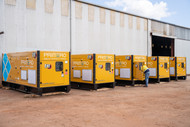Your Guide to Generator Synchronisation
14th Jun 2022
On most construction worksites and mining operations, the more power, the better. Especially in remote locations or areas where there is no access to the grid, generators provide stable, reliable power throughout any operation. So, when it comes to large-scale projects, many worksites benefit from using multiple generators (or paralleling of generators) to supply constant power. In fact, generator paralleling/synchronisation helps control load management, increase power capacity and eases maintenance roadblocks.
Read on to find out everything you need to know about generator synchronisation.
What is Generator Synchronisation?
Generator synchronisation matches the parameters of the generator with the power system before it’s reconnected to it. This will ensures the system runs smoothly throughout its operation. It will match conditions such as voltage, frequency, phase sequence, waveform and phase angle.
Without proper synchronisation, the generator won’t be able to output reliable power. So, when generators are paired with any power system, the parameters must match closely, if not exactly.
How Do You Synchronise a Generator?
The synchronisation process is completed by controlling the exciter current and the generator engine speed. In doing so, the process will match the parameters of one alternator (generator) to the other, or to the bus bar (electrical grid). As a result, synchronising (or paralleling) generators combines the electrical output of multiple generators to work synergistically.
The Benefits: Why Do You Need Generator Synchronisation?
Because electrical loads will vary and are not constant, connecting two or more alternators in parallel is necessary to supply larger loads. As a result, generator synchronisation is required when there are two or more alternators working harmoniously to output power to the load. Here’s why:
Load Requirements
Load requirements can change regularly throughout the day. Generator synchronisation allows you to tailor the power system to accommodate light or heavy loads by activating the right amount of active generators needed. If there is a need for demanding loads during peak loading, synchronisation help achieve this. On the other hand, it can also adjust the output to meet lighter loads.
Increases Reliability
The power of multiple generators is stronger than one - and much more reliable. Using a single unit of power will risk the entire operation to fail if the generator fails. Synchronised systems omit this risk by being able to continue operation - even if one unit fails, the remaining units will continue to run without the whole system shutting down.
Improves Efficiency
Generators are at their most efficient when they run at their load rating. Because electrical loads usually do not maintain consistency, any variation can cause the power capacity of the generator to lull below what is optimal. This dips efficiency levels and may even cause fuel issues and underloading over time. Generator synchronisation allows the alternators to adapt to load changes so the system can remain as efficient as possible throughout operation.
Continuous Service
Generators need to be taken offline to apply any maintenance, repair or servicing, which can cause time delays or additional costs to hire in a replacement generator during this time. Generator synchronisation allows the other generators to remain active and running if one generator needs to be removed from operation. Operations can continue as normal, without interruption or disruption.
Capacity is Expanded
Especially in the case of large-scale construction, farming or mining operations, big operations require as much power as possible. Generator synchronisation allows power systems to have more generators to increase the capacity of power supplied to the site. This also allows for scalability as an operation or worksite grows.
What are the Requirements of Generator Synchronisation?
Before beginning generator synchronisation, the right parameters need to be met to ensure a successful process. These parameters must closely, if not exactly match to ensure generators run smoothly. These parameters include:
- Phase sequence
- Voltage magnitude
- Frequency
- Phase angle
Phase Sequence
Phase sequence refers to the phases of the generator. All three phases of the alternator being connected to the power system must run at the same sequence as that of the phases of the bus bar/electrical grid. This is something that can arise after the initial installation or subsequent to maintenance.
Voltage Magnitude
Incorrect voltage parameters can cause severe disruptions if they do not match. The RMS voltage of the alternator (generator) should also match the voltage of the bus bar or electrical grid. If the voltage of the generator is more than the voltage of the electrical grid, there will be a current of highly reactive power flowing from the generator into the grid, causing potential safety concerns. If the incoming voltage is lower than the electrical grid, the generator will absorb the reactive power, causing it to fail.
Frequency
Unequal frequencies between the generator and the power grid result in a highly unstable flow of energy. This could either mean a high acceleration and deceleration in the prime mover, increasing the transient torque, risking potentially damaging the equipment.
Phase Angle
The phase angle can be observed by differentiating the occurrence of the zero crossing or peaks of the voltage waveforms. The generator voltage and the voltage of the electrical must be at zero.
Techniques for Synchronisation
There are three primary techniques for synchronisation, including:
- Three dark lamps method
- Two bright and one dark lamp method
- Synchroscope method
The purpose of these methods is to appropriately check all the conditions when connecting the generators together for synchronisation. In doing so, they ensure the parameters of the phase angle, voltage, frequency and phase sequence are all being met.
Three Dark Lamps Method
The three dark lamps method tests the parameters of the generator when connecting to the electrical grid. Usually, this occurs with one generator already connected, while testing is carried out to any subsequent generators. Each lamp is connected to the electrical grid and the terminals of any subsequent generator via a synchronising switch.
If any parameters don’t match between the generator and the grid, the lamps will either flicker or shine bright depending on the discrepency. If there is a discrepancy in the frequency, for example, while all other parameters match, the lights will flicker simulataneously. Similarly, if the phase sequence of the generator doesn’t match, the lamps will flicker one by one.
When the voltage of the grid and the generator doesn’t match but all other conditions are satisfied, the lamps will all shine bright. On the other hand, if all parameters match, the lamps will go dark.
The three lamps method is the most preferred method of generator synchronisation because it’s easy to identify the phase sequence in comparison to other methods. It’s also the more cost-effective option compared to other methods.
Two Bright and One Dark Lamp Method
The two bright and one dark lamp method is commonly used to identify whether the alternator frequency is lower or higher than the electrical grid. This is determined via the sequence of the lamps becoming dark and bright.
For example, if the frequency is higher than the grid then the sequence of becoming light and dark will be L1 - L2 - L3. On the other hand, if the frequency is lower than the grid, then the sequence will be L1 - L3 - L2. The synchronising switch is closed when the L1 and L3 lamps are bright and L2 is dark.
Synchroscope Method
This method is similar to the two bright and one dark method in that it can check if the generator frequency is higher or lower than the frequency of the electrical grid. But the synchroscope includes two pairs of terminals and gives a more accurate reading. One terminal is marked as ‘existing’ and is connected across the grid terminals or the existing generator. The other is marked as ‘incoming’ and is connected across the terminals of the incoming generator.
The synchroscope features a dial with a hinged arrow to rotate clockwise and anticlockwise. The rate at which the arrow rotates identifies the discrepancy between the incoming generator and the electrical grid. The rotation rate of the arrow will become smaller when the parameters are correctly adjusted . Once the right corrections are made to control the speed of the generator, the rate of rotation should be minimised as much as possible.
Although this method can be used for the synchronisation process, it’s always recommended to use a set of lights to double check.
What is the Outcome of Faulty Generator Synchronisation?
When a faulty synchronisation process occurs, or when synchronisation is poorly executed it can risk the following:
- The generator or the prime mover can be damaged because of the mechanical stress due to rapid acceleration and deceleration
- Damage to the generator due to high currents
- Overall disturbance to the overall power system, including deviating voltages and oscillations
- Restricts the generator from staying active and potential shut off
Need Expert Advice for Your Generator Synchronisation Requirements?
With years of experience servicing the mining, construction industries, Blue Diamond Machinery has the equipment you need and can rely on. We not only offer expert advice and industry-leading warranties, we provide an all-encompassing generator synchronisation solution. We will customise and install your power solution to your specific power demand requirements, wherever you are. Get in touch with our team today.



